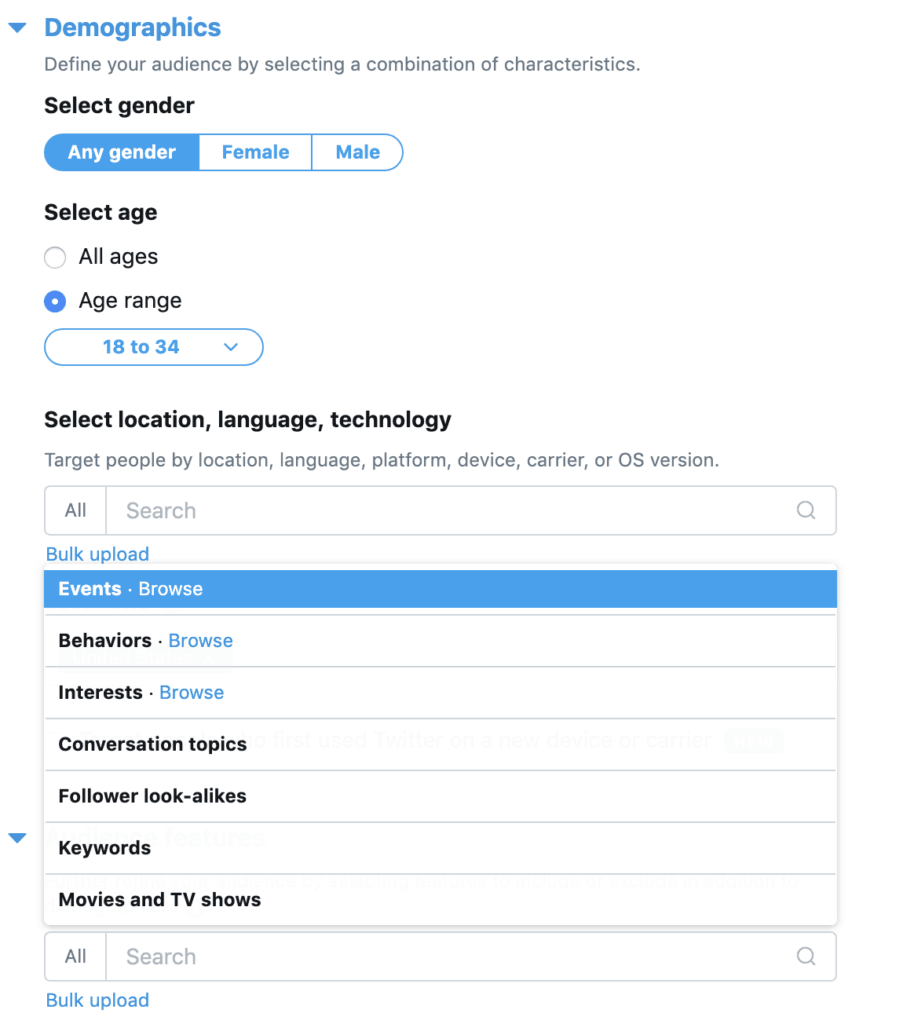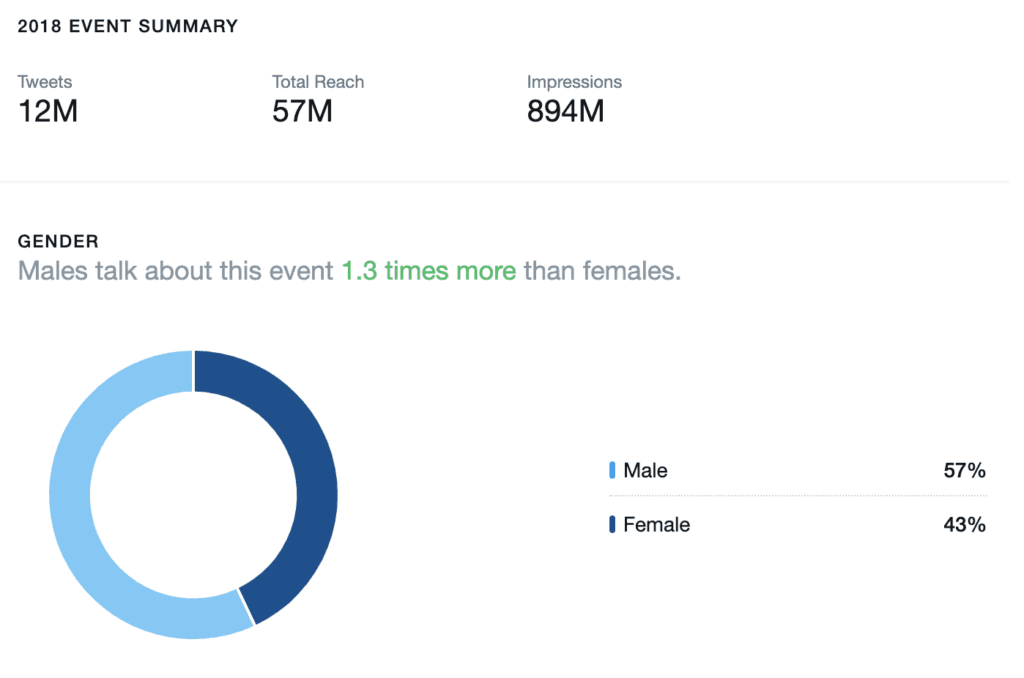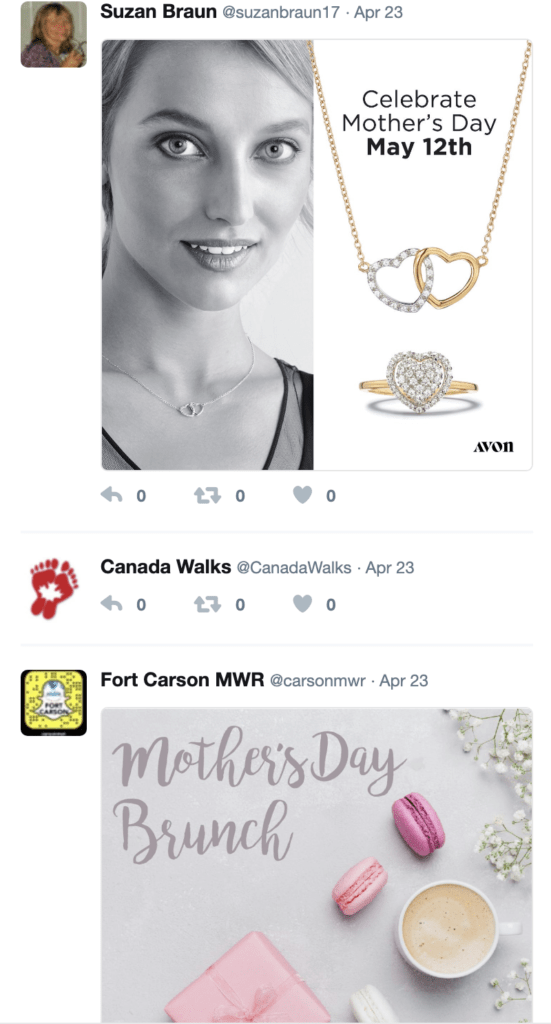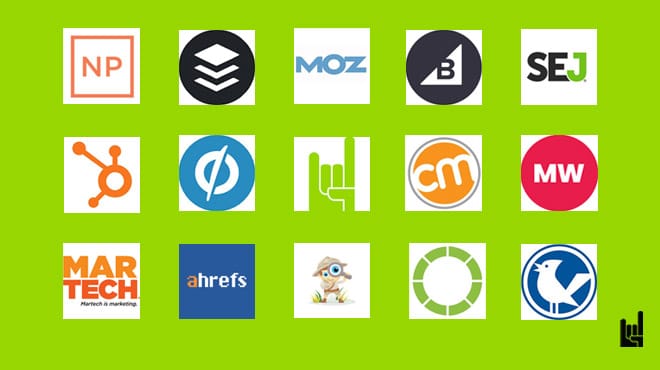Organic reach on a well-crafted Twitter strategy is probably the best it gets on social networks. And the best part of Twitter marketing is the real-time immediacy of the platform.
However, despite the depth of organic reach possibility on Twitter, the ad spend by advertisers dwarfs that of Facebook:

So why advertise on Twitter in the first place? 94% of users plan on purchasing the businesses that they follow.
69% of users have purchased because of something they saw on Twitter. And right about 66% of users discovered a new brand on Twitter. Twitter is a network with buying power. That’s what makes it different, marketing-wise.
And this guide will help you make the most out of it.
What Event Targeting is all about
Cultural moments in our lives are amplified by social media every day the world over. Those moments can take the form of fashion weeks, sporting events, and even holidays. Millions of people are turning to social networks. And if you’re looking for real-time engagement, Twitter is one of the best networks for that. Thanks to Twitter, you can drum up live attention and engagement metrics to your campaigns. Advertisers have long wanted to engage with live audiences on social media.
To answer that call, Twitter created event targeting. But what exactly is event targeting?
Even targeting is a fast and simple way to reach target demographics that are actively interested in a specific event.
During major events, brands often try to patch a strategy together. These strategies are usually based on hashtag guesswork and targeting specific accounts. It’s been a difficult process, with strategy almost always lagging behind the speed of the platform.
This is an archaic process for the smart marketer to pursue. The event targeting feature allows businesses to reach people engaged with live events on the network. Event targeting on Twitter allows marketers to simplify and automate efforts during live events with three core elements:
- A calendar that highlights the major global events. These events can be related to sports, holidays, television, music, and politics in key markets like the United States, the United Kingdom, France, Brazil, and Japan. Advertisers using this feature can filter by type of event, location, and date.
- Event Insights that provide rich, historical data about how events have performed on Twitter’s network. These insights provide the opportunity for analysis based on how many people have tweeted, how many people those tweets reached, device usage and demographics about the audience for specific events. Insights also display the most popular hashtags, keywords, and even the most-engaged tweet. This function allows marketers to develop creative based on what has been powerful in the past.
- Event activation that enables marketers to launch ad campaigns that target events with a single click. This activation can be stacked with other Twitter ad targeting features like gender, language, and device.
Event targeting gives savvy marketers a competitive edge. Now they will be able to adjust their content based on prior results of other brands (including competitors). Then, they can allow targeting to be adjusted by Twitter’s algorithm, removing the guesswork associated previously with event-based marketing!
Twitter Ad Campaign Basics
There are five different types of ad campaigns to run on Twitter. All of them are centred around the specific goals of your brand.
For example, if your campaign objective is to increase website traffic, you pay for the number of clicks that your site gets. If you want to increase your organic audience, you can pay per follower. Marketers who want to boost brand awareness can pay per impression. Increased engagement charges for only the initial engagement with a user.
Not only can you target campaign objectives, but you can also choose from several options to target your audience. Before we can run (to event targeting), we must walk. Targeting Twitter Ads can be an art form. It can make or break your campaign. The best practices you should keep in mind as you build a campaign out are:
- Cover the basics. Select your targeted location, language, and any device targeting options that you want to cover before you dive deeper into the other targeting options out there.
- Select only one type of audience targeting for each campaign. Now, for event targeting, you don’t want to dive too deeply into this because it’s a broader audience than other targeting methods. For additional campaign objectives, choose from Follower, Keyword, Behaviour, Interest, or Tailored Audiences to drive meaningful insights into your campaign.
- Experiment. Most marketers forget about this: Twitter is no different than the majority of paid mediums. And so, testing is key! Testing different approaches allows you to understand which audience is the best fit for your brand and which messages resonate with different groups. You may just be surprised as to what’s most effective for you!
Event Targeting
Follower Targeting
Utilising Follower Targeting allows you to target followers of relevant accounts. These are people who are most likely to share similar interests to a specific brand because they’re already following brands that are similar to yours. By choosing to target the followers of these similar Twitter accounts, Twitter’s algorithm will automatically create an audience based on the interests of those followers.
Follower targeting requires you to do some research first. You should come in prepared, knowing who your competitors, influencers, and similar audiences are.
Best Practices
- Study your niche on Twitter and know which influencers garner the most engagement and follower base.
- Don’t fall into the trap of always targeting accounts with millions of followers. Target the accounts that are most relevant to your brand.
- Start off on the conservative side with 30 usernames per campaign and a goal of 50,000 followers for your potential reach.
- Paid social is never a ‘set it and forget it’ process. Keep your eye on performance during the campaign through Twitter’s Ad Manager. And refine the target audience as you see fit.
Keyword Targeting
Much like SEO and PPC, Twitter gives you the ability to target recently tweeted phrases or searched items. Keyword targeting allows you to be in front of the people you want when it matters the most. You should enter into this targeting method with an idea as to how you want to form your target audience. It is ideal to reach your audience the moment you’re most relevant to them.
Best Practices
- Use the insights you gain from search
- Review after week one- what is working? What isn’t? Which keywords tend to receive more engagement? Add similar keywords to any high performing terms.
- Twitter is 100% about timing. Make sure you take note and establish times when a specific keyword resonates with your people the most.
Emoji Targeting
Twitter began offering emoji targeting to advertisers in 2016. Emoji targeting falls in the same category as keyword targeting. However, advertisers must approach this kind of targeting differently. Marketers should brush up on their understanding of the context of emojis and how they’re being used in the larger conversation. This is the only way to determine if it might be relevant to their business.
Twitter only offers emoji targeting to the emojis that are on this full Unicode emoji list. This list can also help you understand the emoji context.
Best Practices
- Be cautious and only use emojis that make the most sense to your brand. This can be treacherous territory for the uninformed marketer as some emojis have multiple meanings.
- Consider your demographics when it comes to targeting emojis. Some demographics may use them differently or more than other people.
Behaviour Targeting
This is only available to advertisers in the United States and the UK at this time. Behaviour targeting allows you to reach people based on a variety of behaviours. Such behaviours include everything from online and offline purchases to annual household income. You will have other targeting opportunities like the types of restaurants users frequent, their buying styles, or the type of car they own.
Best Practices
- Take the time to narrow what buyer traits you should target based on the style of your brand. The more specific approach you take with buyer traits, the higher cost per click/cost per conversion may be. Don’t let this alarm you, however. If your targeting is accurate, these are bottom of the funnel users.
- Start with the most basic traits first. Test campaign performance, and then layer in specificity as you move forward.
Tailored & Flexible Audience Targeting
You can tailor your audiences through the web, mobile app, or lists in Twitter Ads. These tailored audiences are Twitter’s version of remarketing, allowing you to target people who have come in contact with your brand in the past. Let’s break this down a bit more:
Web: You can target any user that has visited your site or took a specific action. You need to install Twitter’s website tag first, though. Through this tag, you will collect data and target a custom audience via Twitter Cards.
Mobile Apps: Similar to the web process, if you have a mobile app, you can target any user that has taken a specific action on your app. This is really good for post-install events if you are trying to drive registrations or in-app purchases.
Lists: Just upload a complete or segmented CRM list directly to Twitter to target users on your list. You can also upload an email list or use Twitter usernames.
Tailored Audiences are pretty easy to find in the Twitter Ad Manager. It’s the first option you see during campaign creation. If a single tailored audience doesn’t cover every campaign objective, you can combine multiple tailored audiences into a flexible audience. This way will allow you to provide better coverage for your KPIs.
Best Practices
- Refine audiences by combining tailored audiences with one of the other Twitter Ad targeting options (except for event targeting, but more on that later)
- Utilising lookalike targeting to discover new audience opportunities that you may be missing.
Interest Targeting
The use of interests in advertiser targeting has become prolific across almost every network. Twitter is not any different. Brands can target audiences/people based on broad or specific interests that can run parallel to their business. There are 25 interest categories you can choose from. These categories extend into 350 deeper sub-categories. Twitter allows two interests max. per campaign. Thus, to refine your selected audience, it’s best to monitor what’s working and what isn’t. Then adjust your interests as needed.
Best Practices
- Twitter’s interests are fairly broad. You’ll need to focus on their wide variety of sub-categories available to narrow your campaign’s target audience
- If you feel that more categories meet your campaign objectives, split test the categories to determine the optimal settings.
Twitter Event Targeting Applications
Engagement
Remember, Twitter event targeting is all about the reach. It’s excellent for campaigns focused around engagement. The gathering of seemingly unrelated groups on the network provides a massive opportunity for advertisers to reach users who are both highly engaged and relevant audiences to their brand. Otherwise, they may have never been targeted.
The real-time urgency of Twitter has always presented an opportunity for brands to identify with their audiences to demonstrate relevancy and drive awareness of their values.
There are a few pro-tips that you should know about. Even savvy marketers can fall victim to these, so pay attention:
- Target only the events or content that align with brand values and messaging
- Use additional targeting measures to ensure relevancy
- Tailor all creative to the event. This is your chance to be clever! It plays well on Twitter in this space
- Always remain mindful of sensitive topics and utilise positive sentiment targeting
Select Your Audience
Creating an audience that is perfectly matched to campaign objectives always begins with research. Before you even start building an event targeting campaign, you should build an audience profile with basic demographics in your Twitter ad account.

With Twitter’s events calendar, you can decide on an event that you feel attracts your targeted demographic, targeting it with a single click.
Match with an event
For event targeting to be impactful to your overall campaign objectives, choosing an event that appeals and resonates with your audience is essential. In Twitter ads, you can take a deep dive into the demographics of people who are chatting about a specific event. Here are the stats for Mother’s Day 2018:

Under the ‘analytics’ section of your Twitter ads account, you can discover more well-aligned events that, perhaps, weren’t so obvious. Discover events that weren’t on your radar easily by filtering for event type, date and location.
Then, Twitter broadcasts any promoted tweets and videos to your chosen target audience. The broadcast is based only on the people who are participating in an event and following along for updates. This helps you get in front of the right people at the precise moment they’re the most engaged on the network. Layering demographic and geographic targeting can help to refine the audience.
💡 Also read: Best Twitter Video Tools
Nonetheless, don’t use tailored audiences or any additional targeting as it may limit your campaign’s reach.
Twitter designed event targeting so that advertisers have an option to weed out irrelevant conversation and chatter that doesn’t apply to your target market or campaign objectives. Their algorithm analyses the content of Tweets while relying on keywords and other contextual cues to zero in on the conversations related to the event and audience that you’re targeting.
The event summary page under ‘Analytics’ on the dashboard also features tweets that were sent by various users and advertisers during the previous year’s event. Planning your campaign just got super easy! Check and see what kind of content got the most Retweets and engagement. Find for a unique angle to introduce your brand to the conversation.
Use event-specific hashtags and keywords
Using trending words and phrases can help you appeal more to your audience. In the Twitter event targeting, you can see what other people have been saying about the event you’re targeting. Then, you can use that data to inspire and tailor your campaign creative.
Twitter starts tracking event audiences 30 days before the event even begins to give advertisers plenty of time to plan their campaigns. This is a prime time to seed interest by warming up your audience to your campaign early on. This allows you to increase the list of people engaging with the event. As the event approaches and the activity levels rise, connections will multiply, and you’ll find that your campaign is at the centre of a growing crowd.
You can’t always predict the real-time spontaneous moments that happen during live events, but you can prepare for them. Twitter’s Quick Promote allows you to act quickly when new discussion spikes surrounding a relevant event. Quick Promote helps you to centre your brand in the conversation as it happens.
Content Marketing
Everyone knows that content strategy dictates that your content should add value to the community it’s designed to serve. However, every year it becomes more and more difficult to get in front of those communities in digital spaces. Therefore, it’s crucial that you utilise every tool that you have in your paid earned, and owned media marketing mix. Targeting the communities you want to reach, and the paid platform posts that speak to them is definitely a large part of the marketing mix puzzle. Twitter’s targeting capabilities are phenomenal for content marketers.
With events like conferences, seminars, programs, TV shows, or holidays – combining Twitter and hashtags continue to be an amazing power duo. Before 2015, they were one of the only options for targeting on this level. Now, with Twitter’s event targeting, the entire arena has changed.

First, set up a promoted post and you’ll eventually see an option to ‘add event targeting’ in the settings. Choose only one targeted event per campaign.
Targeting specific hashtags is a smart approach, adding reach and focus to your campaigns.
Simply logging into the ads interface gives advertisers access to Twitter’s event calendar. As noted above, this provides deep insight and advanced information about relative audience sizes, anticipated traffic demographic breakdowns and much more. This tactic gives your campaigns a head start, utilising a data-driven approach to proof content and engagement of previous events before it ever reaches your audience’s eyeballs.
The events calendar isn’t limited to just conferences or movie releases. You can take a look at ‘Recurring Trends’ in the analytics section to decipher other great ways to target the communities you wish to reach.

This gives you a head start. As most savvy marketers are aware, the real value of targeting comes after the promoted campaign. This is when you can look back at your data and decipher the results around your goals and objectives.
Content Plan
Perhaps the coolest part of Twitter’s event targeting is the robust data that you can use to give your campaigns a much-needed data-driven boost in engagement. As discussed, every event has rich insights built into the calendar in the ‘Analytics’ section of the Twitter Ads dashboard. This shows tweets from the previous year’s event:

You don’t have to run an ad campaign to use this! It can be used as inspiration for your organic campaigns around holidays. Research which tweets had the most engagement. Which hashtags did they use? What was the rationale of the creative? What made the copy funny or witty? Take copy that has shown (through the data) to be successful in the past and put your own unique brand spin.
Look at what creative has done well. Is there a particular aesthetic or ‘feel’ to the images used on the most successful tweets? Likely, you will not have the reach of someone like Barack Obama or Kim Kardashian. But it highlights popular content from users of Twitter that aren’t famous. Paying attention to these gives you valuable information about what resonates with the particular audience of any specific event.
Twitter Event Targeting doesn’t just focus on past tweets. Twitter starts gathering data on an audience of any specific event up to 30 days before the actual event so that advertisers have time to research and build out their campaigns. This means that you can also click on ‘live tweets’ inside of the Event Calendar to see what people are talking about before the actual event:

This gives you a chance to see what other users are doing for the holiday, which creative resonates (and which ones do not).

Kristen Bowie is a marketing leader, forging the path with data-driven decisions. When she’s not writing for thought leadership and creating sponsorship proposals at Qwilr, she’s hanging out with her two urban dwarf goats, painting, or is out watching a local band.



